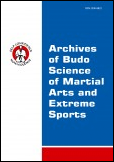2016, Volume 12, Issue 1
The use of functional tests to assess risk of injuries in judokas
Dariusz Boguszewski1, Jakub Adamczyk2, Małgorzata Buda3, Maria Kłoda1, Dariusz Białoszewski1
1Second Medical Faculty, Department of Rehabilitation, Physiotherapy Division. Medical University of Warsaw, Poland, Warszawa, Poland
2Physical Education Faculty, Institute of Theory of Sport. University of Physical Education in Warsaw, Poland , Warszawa, Poland
3Doctoral studies. University of Physical Education in Warsaw, Poland, Warszawa, Poland
Author for correspondence: Dariusz Boguszewski; Second Medical Faculty, Department of Rehabilitation, Physiotherapy Division. Medical University of Warsaw, Poland, Warszawa, Poland; email: dwb[at]o2.pl
Full text
Abstract
Background & Study Aim: High physical fitness requirements towards judokas, as well as the combat specificity may foster bodily injuries. The research objective was to identify the spinal joints, hip joints and shoulder joints mobility in relation to bodily injuries sustained by men practising judo (as professional or amateur sportsmen).
Material & Methods. Forty one men practising judo divided into two groups according to the level of sport advancement were considered for participation in this study. Group 1 (G1 – the study group) were 15 professional sportsmen. Group 2 (G2 – the control group) were recreational, amateur sportsmen (n = 26). The research tool consisted of a series of functional tests: (the Dega wall test, Thomas test, Thomayer test and Zipper – Back Scratch Test), as well as a custom survey on training methods, the number, type and circumstances of contracted injuries, as well as their treatment methods.
Results: Iliopsoas contracture was observed in 14 judokas (93%) in G1 and 15 judokas (58%) in G2. Thirteen practitioners in G1 and 11 in G2 scored negative in the Dega test, compared to 14 judokas in G1 and 7 judokas in G2 scored negative in the Back Scratch Test. Significant asymmetry was also observed in both groups: the discrepancy between the left and the right side amounted to p = 0.002 for G1 and p<0.001 for G2. A notably higher number of bodily injuries (p = 0.022) was noted among professional judo athletes.
Conclusions: The degree of functional limitations may be the effect, yet also the cause of bodily injuries. The majority of professional practitioners had limited joint flexibility (which may increase the risk of injury to this body part). This demonstrates an insufficient amount of stretching exercises during training.
Key words: Thomayer test, Thomas test, Dega test, Back Scratch Test





